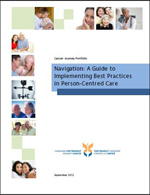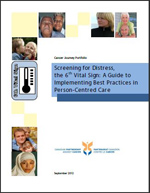New guides available to boost two key components of person-centred care
March 25, 2013
 Expanded implementation guides for the growing fields of patient navigation and screening for distress are now available to help improve the cancer journey for patients.
Expanded implementation guides for the growing fields of patient navigation and screening for distress are now available to help improve the cancer journey for patients.
“In recent years, understanding of the need for both of these core elements of person-centred care has expanded rapidly,” says Dr. Margaret Fitch, Expert Lead of the patient experience and survivorship initiatives of the Person-Centred Perspective at the Partnership.
“These guides exist because of the collective will of practitioners to share expertise and learn from each other. We all strive to get the best possible programs in place for patients as quickly as possible and by working together we can improve our own programs as well as help those in the early stages of initiating programs for their patients.”
Navigation: A Guide to Implementing Best Practices in Person-Centred Care
 The new navigation guide, which builds on a working document released in 2010, describes the different types of navigation programs as well as highlighting promising practices, quality and change management initiatives and providing an evaluation framework. Navigation refers to a structured approach to helping patients access the most appropriate care and resources offered by the cancer system.
The new navigation guide, which builds on a working document released in 2010, describes the different types of navigation programs as well as highlighting promising practices, quality and change management initiatives and providing an evaluation framework. Navigation refers to a structured approach to helping patients access the most appropriate care and resources offered by the cancer system.
Chris Power, Division Manager with Eastern Health’s provincial Cancer Care Program (Newfoundland and Labrador), says the original guide, entitled, Guide To Implementing Navigation, was invaluable in establishing the province’s professional patient navigation program, which began with nurse navigators in 2011. She is looking forward to putting the expanded guide to use. “I see the new guide being instrumental as we complete our evaluation and plan our next steps. It will be very helpful in guiding the future developments of our program.”
“For jurisdictions who are just starting out, this is a very good, in-depth and comprehensive guide to use when planning your program. It provides information on the development of patient navigation within Canada, as well as detailed information around professional navigation versus peer navigation, and also virtual navigation. It is also helpful when looking at the change management, an essential component with any new program implementation.”
 Cancer patients often report distress that is severe enough to affect their ability to cope effectively with their diagnosis, as documented in the expanded guide to implementing screening for distress. This has led to growing efforts to systematically identify and measure levels of distress. Cancer program accreditation standards in Canada now include screening for distress as an element in accreditation.
Cancer patients often report distress that is severe enough to affect their ability to cope effectively with their diagnosis, as documented in the expanded guide to implementing screening for distress. This has led to growing efforts to systematically identify and measure levels of distress. Cancer program accreditation standards in Canada now include screening for distress as an element in accreditation.
The revised implementation guide builds on a working draft released in 2009. The guide offers a series of modules providing the steps and considerations necessary to implement a screening for distress program and includes strategies and techniques based on insights from nine jurisdictions that were monitored while implementing screening for distress, as well as links to useful tools and resources.
“The guide was remarkable,” says Deb Bulych, Provincial Leader, Supportive Care with the Saskatchewan Cancer Agency. She credits it with kick-starting the program when they began screening for distress in 2010. “It was really the roadmap and the toolkit we needed to just get going.”
Saskatchewan now offers nurse-implemented screening for distress to new patients. “The revised guide is wonderful because it shares information about maintaining momentum and sustainability which is another very practical piece of work that we are all involved in right now,” says Bulych.
“It is so well laid out, providing you with the evidence base, the steps for implementation, and it shows you the potential outcome. One of the exciting aspects of the original tool was that two key areas were identified by our patients as significant and at times unmet needs – one was fatigue and one was sexuality. We trained staff in both of those areas and have developed provincial programs. It informed a practice change for us.”
